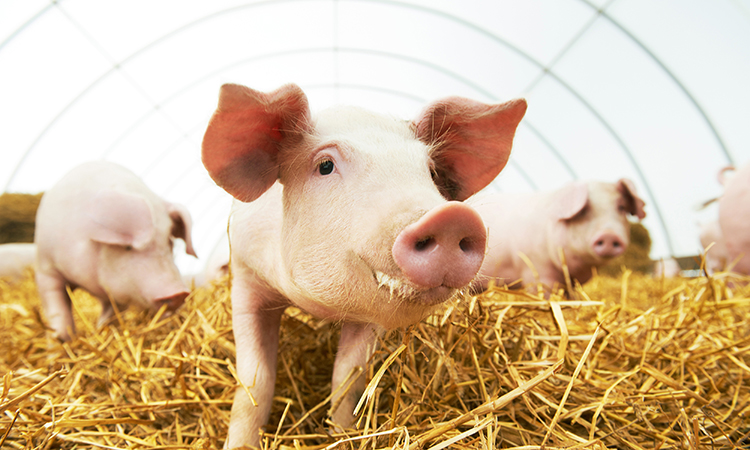New research reveals British pig farming is reducing carbon footprint
- Like
- Digg
- Del
- Tumblr
- VKontakte
- Buffer
- Love This
- Odnoklassniki
- Meneame
- Blogger
- Amazon
- Yahoo Mail
- Gmail
- AOL
- Newsvine
- HackerNews
- Evernote
- MySpace
- Mail.ru
- Viadeo
- Line
- Comments
- Yummly
- SMS
- Viber
- Telegram
- Subscribe
- Skype
- Facebook Messenger
- Kakao
- LiveJournal
- Yammer
- Edgar
- Fintel
- Mix
- Instapaper
- Copy Link
Posted: 25 February 2021 | Joshua Minchin (New Food) | 1 comment
New research from Queen’s University Belfast suggests a change in feed was key to reducing the carbon impact of pig farming in the UK.


The carbon footprint of British pig farming has reduced by almost 40 percent over the last 20 years, according to a new study, using a new methodology, led by the Institute for Global Food Security (IGFS) at Queen’s University Belfast, Northern Ireland.
The independent research, funded by the EU, drew its conclusions from historic data on livestock systems across England, Scotland and Wales. Because the data on agricultural inputs was sparse, a new research methodology was developed in which outputs were used to retrospectively estimate inputs – a process called ‘inverted modelling’.
Northern Ireland (NI) was not included in the study, but the research team says there are plans to extend the methodology to NI in the near future.
Globally, agricultural systems have come under pressure to reduce their carbon footprint and the UK government has set a target of ‘carbon neutral’ farming by 2050.
Calculating the carbon footprint of a farming system is a complex metric involving a large number of indicators, including what kind of fuel is used on the farm, how the soil is cultivated, the style of land management, and the types of animals and crops being farmed.
Pig meat is the most widely produced and consumed category of meat globally (FAO STATs, 2019) and thus, contributes significantly to several forms of environmental impacts, despite the research team claiming that the environmental impact per unit of pig meat is relatively low.
In this new study, an overall drop in carbon footprint was evidenced across the pig farming sector, breaking down, for indoor and outdoor-bred pigs respectively, to reductions of 37.0 percent and 35.4 percent for Global Warming Potential (commonly known as carbon footprint).
The role of animal feed was found to be central to the environmental impact of pig farms – accounting for between 75-80 percent of carbon footprint. According to the research team, changes to feed ingredients had the potential to significantly alter the carbon rating of pig farms and the industry as a whole.
Specifically, the increasing trend of replacing soya imported from South America (which researchers say has a high environmental footprint associated with deforestation) with home-grown crops such as rapeseed and sunflower meal to feed pigs was found to have a significant mitigating effect on environmental outputs.
The study was led by Professor Ilias Kyriazakis from IGFS in collaboration with other UK institutions, interrogating publicly available Agriculture and Horticulture Development Board (AHDB) data from Great Britain from 2000-2020.
He believes it’s the first time inverted modelling has been used to investigate the environmental impact of any livestock system, marking a departure for research into the whole area of farming and carbon.
“The reason this research is so significant is that it shows an area of livestock farming where carbon footprint has been reducing over the past 20 years, almost under the radar,” said Prof Kyriazakis.
“We hear a lot these days about the need for farmers to reduce their carbon outputs for the sake of the environment, especially as it applies to beef and dairy cattle farming. There is much more attention focused on ruminant food systems as they produce higher GHG emissions.
“But I believe there are important lessons to be learned from this study – not only for better environmental management as it relates to pig farming, but potentially for all livestock systems. Some of the improvements identified in this study potentially could be applied to other animal systems, which would ultimately help move our collective agriculture systems towards a carbon-neutral model.”
Related topics
Related organisations
Agriculture and Horticulture Development Board (AHDB), Institute for Global Food Security, Queen's University Belfast, The UN Food and Agriculture Organization’s (FAO)










Hi,
I was loosely involved in the 1980’s on a low impact pig farm. While I am now too old to get involved physically I can still talk about the ideas used if someone has time